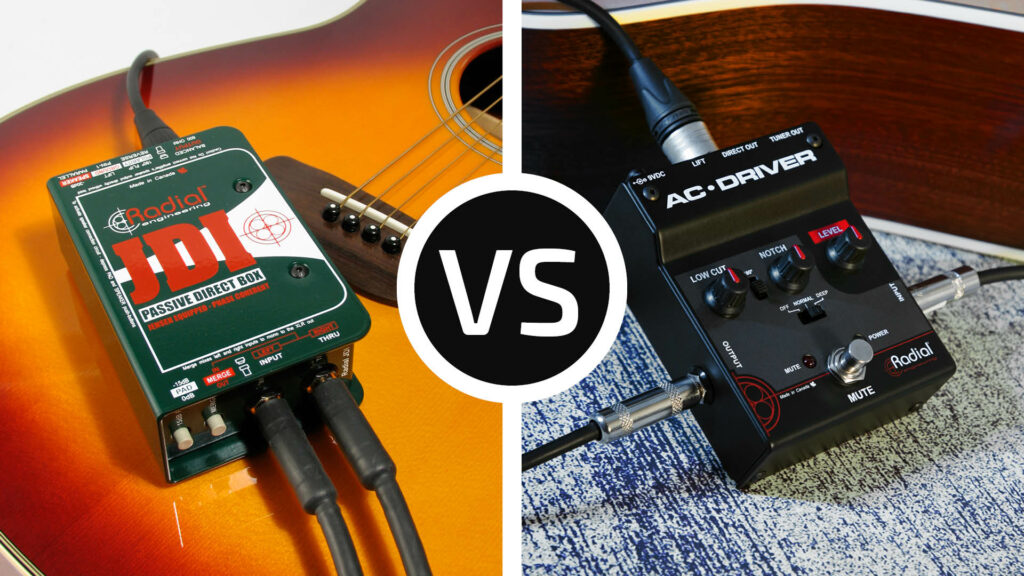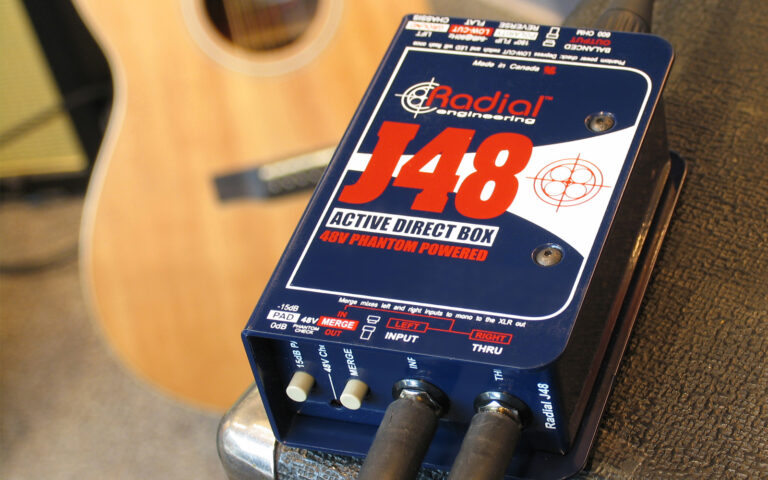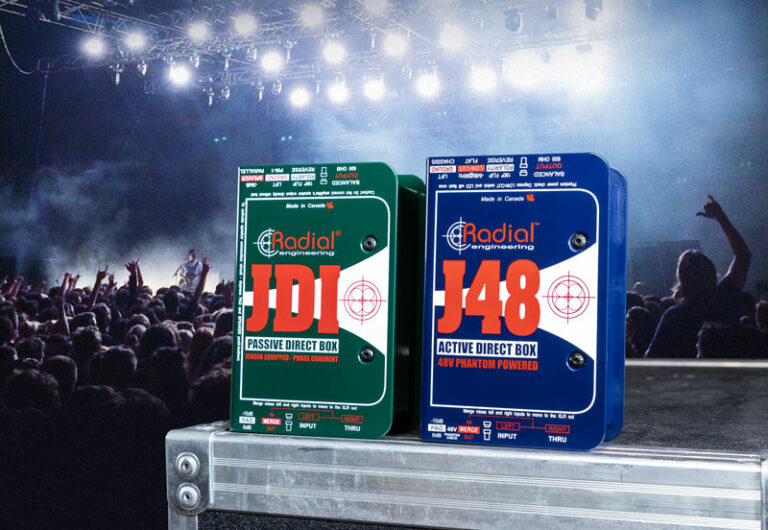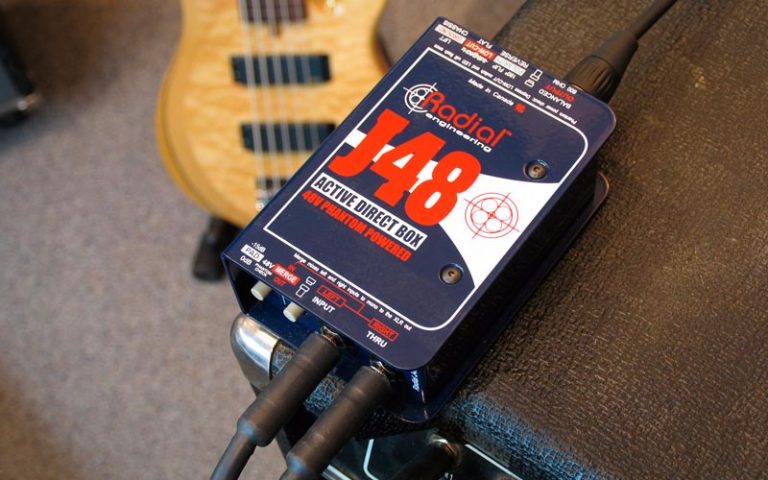Choosing a direct box vs an instrument preamp for bass guitars and acoustic instruments
We are often asked by acoustic and bass guitar players how to tell whether a direct box or a preamp is the right choice for their instrument and setup requirements. If you are regularly performing on stage or recording in the studio, it’s imperative to have a good quality direct box to interface your instrument with the necessary pro audio equipment to perform or record. But where do instrument preamps come into play, and when should you consider using one? This post intends to navigate the various options available for acoustic guitar players, bass players, and other acoustic instrumentalists, so you can make the right choice for your needs.
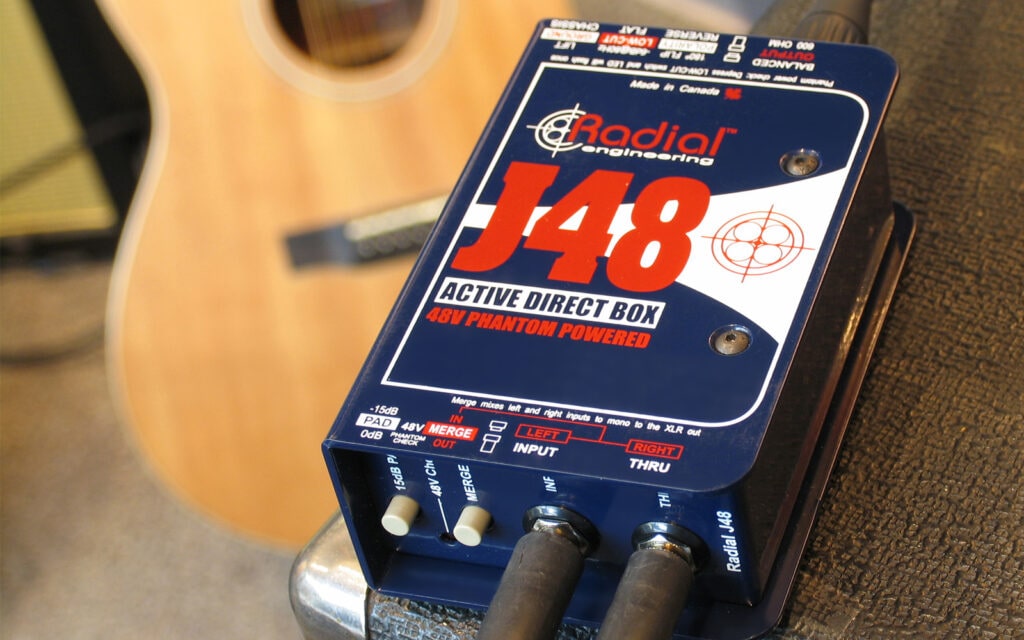
Starting with the basics – using a direct box
A direct box serves two main purposes: the first is to take the signal from your guitar or instrument and optimize it for feeding into pro audio equipment such as a PA system, mixer or recording interface. This requires converting the audio from a high-impedance, unbalanced instrument level connection to a low-impedance, balanced mic-level signal, and it provides the added benefit of allowing you to connect the output of the D.I. over long cable lengths of up to 300ft without significant audio degradation or noise. The second use for a D.I. is to take a split of your original signal (usually from an output labeled Thru) that you can use to feed a nearby amplifier, either for monitoring on stage or to record with a microphone.
Let’s take a look at three popular D.I.s and the type of instruments they are best suited for.
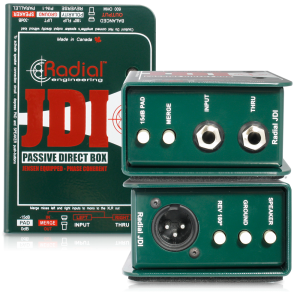
JDI:
- acoustic guitar with a built in preamp
- acoustic guitar using pedal effects
- active bass guitar
The JDI, along with the J48 mentioned below, are industry-leading direct boxes, meaning they are found in studios and on stages all over the world by the biggest names in audio. One reason for this is that they are built with an uncompromising approach towards maintaining the tone and integrity of your instrument’s signal; the JDI features a premium Jensen transformer for exactly this purpose. A high quality transformer is what makes a passive direct box work, and it can handle incredibly hot input signal levels without distortion, which makes it ideal for high gain devices like active basses and guitar pedal chains. Transformer-based direct boxes also have the ability to saturate your tone at high input levels instead of clipping the signal, which is why acoustic guitar players who use built in preamps love how it can smooth out their tone while still sounding natural. As an added benefit, the JDI is easy to put into use at any venue as it requires no power to operate.
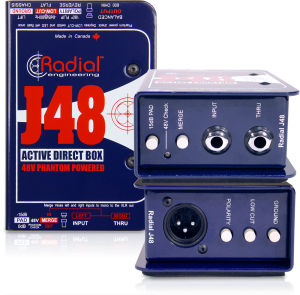
J48:
- acoustic guitar with magnetic pickups
- passive bass guitar
The J48 is an active direct box, meaning it requires power (in the form of 48V phantom power) from the PA system or a recording interface to work. Active D.I.s work as unity gain preamplifiers, and they buffer your signal to prevent degradation and high frequency loss over long cable runs. An active D.I. will help give your instrument more high end ‘reach’ that can breathe extra life into passive instruments such as acoustics without built in preamps or bass guitars with passive pickups. This also makes the J48 a favorite of countless electric guitar players with magnetic pickups.
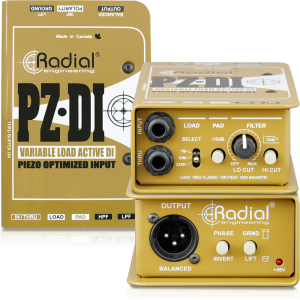
PZ-DI:
- piezo equipped acoustic guitar or upright bass
- other acoustic instruments such as mandolin
The PZ-DI is another active direct box that borrows circuitry from the J48, but also includes features that are particularly appealing for use with multiple types of acoustic instruments. One such feature is the load selector switch, which allows you to choose between three input impedance values. This is of particular importance for guitars or basses that use piezo transducers without a built in preamp – piezos are notorious for their ‘squawk’ or harsh tone when used with typical D.I.s and preamps, but they can be tamed by pairing them with an ultra-high input impedance that vastly improve their performance. The PZ-DI also has a low pass filter that can be engaged to help eliminate feedback on stage, and a variable high pass filter that can remove excess low frequencies from basses or cut out unwanted low end from other instruments like mandolins or violins.
One thing you’ll notice with these devices is that they have limited options for adjusting the sound of your instrument, even considering the additional features on the PZ-DI. This is by design, as direct boxes mainly function as interfaces, and while crucial for any gig, they are rarely adjusted mid-set.
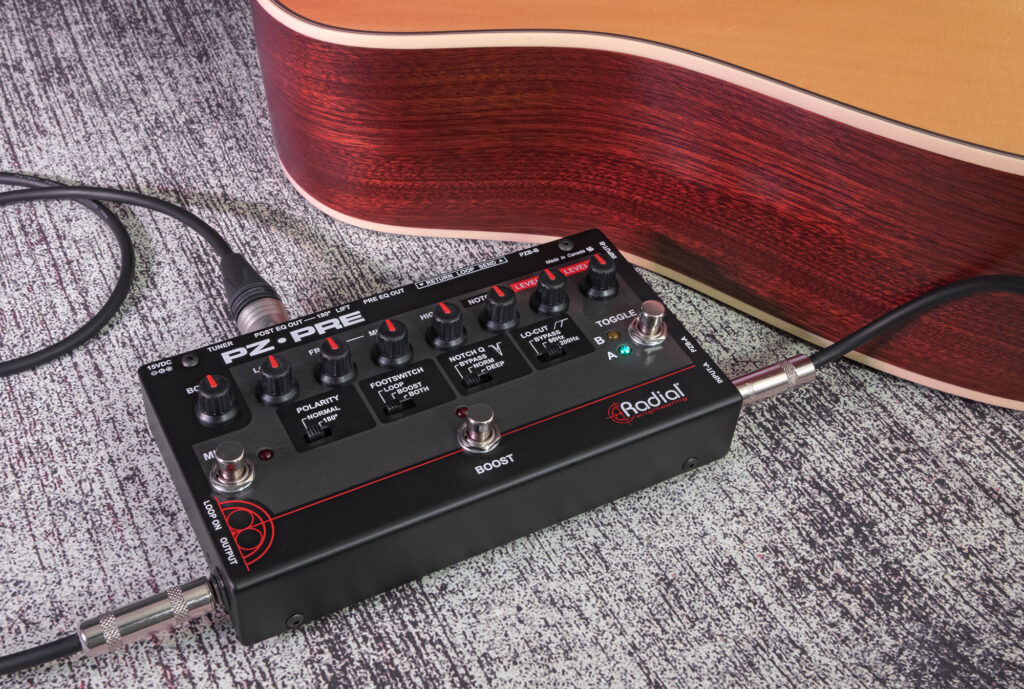
This brings us to instrument preamplifiers, often referred to as simply ‘preamps’ (though not to be confused with mic-preamps, which are specifically designed to bring a microphone signal up to line-level). Instrument preamps often include the same functionality of a direct box, but they take things a step further by adding footswitches that can affect the performance in real-time, as well as tone-shaping features that can help improve your sound or filters that reduce feedback while performing on stage. You might also find connections for effects pedals, built-in signal boosters, multiple inputs that can be switched between on the fly or summed together, and buffered tuner outputs paired with mute switches for silent on-stage tune ups. If you find yourself salivating at the possibility of having any of these options at the press of a footswitch or a turn of the dial, that’s a sign that you should consider adding a preamp to your gig bag.
While your instrument and pickup type will help guide which direct box is right for you, choosing between instrument preamps is more about which features suit your setup and playing style, as most preamps will be able to handle a variety of inputs. Just note that if you have a piezo transducer you should make sure that the preamp includes an option for a high-impedance input of 5Meg ohms or more.
Here is a brief overview of the Acoustic Series lineup and some of their key features and benefits.
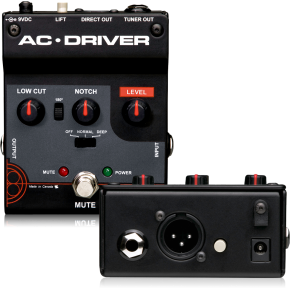
The AC-Driver
The AC-Driver is the perfect companion to a solo gig where you may not have a dedicated sound engineer operating the PA system. You can control feedback onstage by using the adjustable notch filter and polarity reverse switch, clean up excess low frequencies if your sound is too boomy, and a footswitch allows you to mute your signal to the PA instantly so you can silently perform a tune-up between songs or switch instruments. A level control is also provided for on-hand adjustments and to compensate if you switch between instruments that have differing output levels.
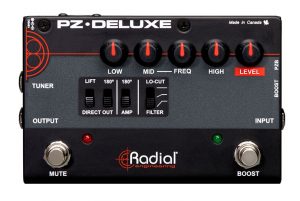
The PZ-Deluxe
The PZ-Deluxe adds even more performance and tone-shaping options for players who want a higher degree of control over their sound, with a three-band EQ section and a footswitch-activated signal booster for soloing. The PZ-Deluxe also features Radial’s PZB booster circuit, which optimizes the connection for piezo transducers by bumping up the input impedance to 10Meg ohms and providing a front-end level boost of +10dB for better signal-to-noise when using these pickup types. This PZB option is also found on the PZ-Pre and the PZ-Pro, mentioned below.
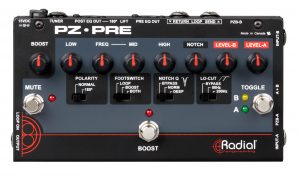
The PZ-Pre
The PZ-Pre isn’t just for tone nuts who want to sculpt their sound; it can also handle complex setups and offers multiple signal routing and switching options. If you want to be able to switch instruments without unplugging a cable, activate your effects pedals, and kick on a powerful clean boost all all from a single device, this is the preamp for you. The PZ-Pre can be thought of as a command center for your acoustic setup, with connections for dual instrument inputs and an effects loop, plus two built-in D.I. outputs – one pre-EQ send to feed the PA system, and another post-EQ output for monitor mixes. It also includes a full EQ section, dual input level controls, and the option to sum the two inputs together. This allows you to blend two pickup types together at once for a full-bodied, record-ready tone.
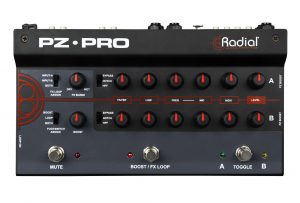
The PZ-Pro
The PZ-Pro is our simplest instrument preamp, in that it simply includes every feature we could possibly think of, all packed into one incredibly versatile unit. The PZ-Pro handles everything the PZ-Pre is capable of, but it also sports a full EQ section for each input channel, plus a microphone input on the second channel for connecting a clip-on or condenser microphone. This means that now you can connect multiple pickup types and EQ each individually to get the best out of each option, whether or not you are switching between the two or blending them together for a best-of-both-worlds summed tone. In addition to this, the FX Loop on the PZ-Pro is assignable between the channels, so you can connect your pedal chain and have it active on channel A, B, or both, with a wet/dry blend knob to make the effect as subtle or as pronounced as you want.
If you are a bass player and want in on the kind of control that the Acoustic Series provides over your sound, no need to worry because we have you covered as well. While the PZ-Pro has lots of appeal for upright bass players that want to blend their piezo-equipped instrument with a microphone, the Bassbone series of preamps suits many other bass guitar applications, with EQ controls and features that are tailored for basses in particular.
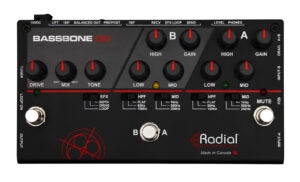
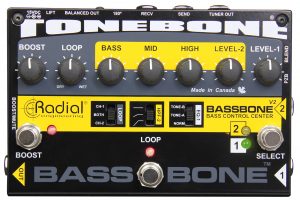
The Bassbone OD and the Bassbone V2
These two bass preamps have a lot of similarities: they both have built-in direct outputs, dual inputs (with one that can accommodate a piezo transducer), an effects loop for pedal chains, and input switching and mute control via footswitches. These features already make them versatile enough to handle a wide variety of playing styles and setups.
In terms of differentiators, the Bassbone OD has a three-band EQ and high pass filter for each individual input, along with a shared overdrive that can be activated with a footswitch. The direct output on this preamp can be assigned from pre-EQ to post-EQ depending on whether you want the bass EQ’d through the PA system or not. Also of interest to many road warriors and apartment dwellers, the Bassbone OD features a headphone output for silent practice that won’t disturb the peace.
The Bassbone V2 places most of its EQ controls on the second channel, which also includes the input for a piezo. It also has a variable clean booster that can be activated using a footswitch. These features provide more appeal for players that swap between electric bass and upright bass during a gig, as they may typically need additional controls to shape the tone of the pickups in the acoustic bass. The Bassbone V2 also has a blend knob that mixes in the returns from your pedal effects, so they can be set at a point where the effects can be heard without losing definition and attack from the original dry track.
We have covered the most popular direct boxes and preamps available for bass players and acoustic instrumentalists, but this conversation wouldn’t be complete without mentioning a third option – one we can aptly call ‘colorful direct boxes’. And no, that doesn’t refer to the wide ranging color palette we use with our product artwork.
These devices combine the features of a direct box with the ability to impart varying degrees of tonal coloration by bringing either tubes or transformers into the signal path to create a one-of-a-kind sound when combined with your instrument.
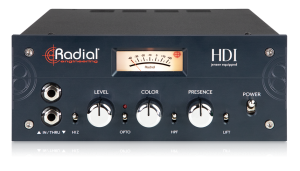
The HDI
The HDI offers a unique sonic footprint not found on any of the other products mentioned in this post, which is due to the fact that we’ve never built a D.I. anything like this before. At its heart is the color control, which can take your signal from ultra clean and pristine on one end, to warm and distorted on the other, creating amp like tones in an instant.
The HDI is the brainchild of legendary designer Hutch Hutchison, who intended for this unique device to sound as musical as possible at every setting, making it easily accessible to both studio engineers as well as instrumentalists. A streamlined feature set belies the high level of control that you can assert over your tone, with a smooth opto compressor that can be engaged for peak reduction, and a presence knob that provides extra detail and top end bite that cuts through a mix. The HDI looks at home in a high end recording studio, but it’s also built with the rugged durability that radial D.I. boxes are known for, and it can make a huge impact on stage when used for live performance.
Conclusion
By now it’s probably clear that an incredibly wide range of options awaits if you are interested in having more control over the tone of your instrument, both in the studio and on a live stage. From no-fuss passive direct boxes to full-featured instrument preamps that can be endlessly reconfigured, there is something out there to suit the needs of every musician. Hopefully this article has given you a taste of the many choices available. If you want to know more about any of these products feel free to drop us a line at support@radialeng.com, we would love to hear from you.



